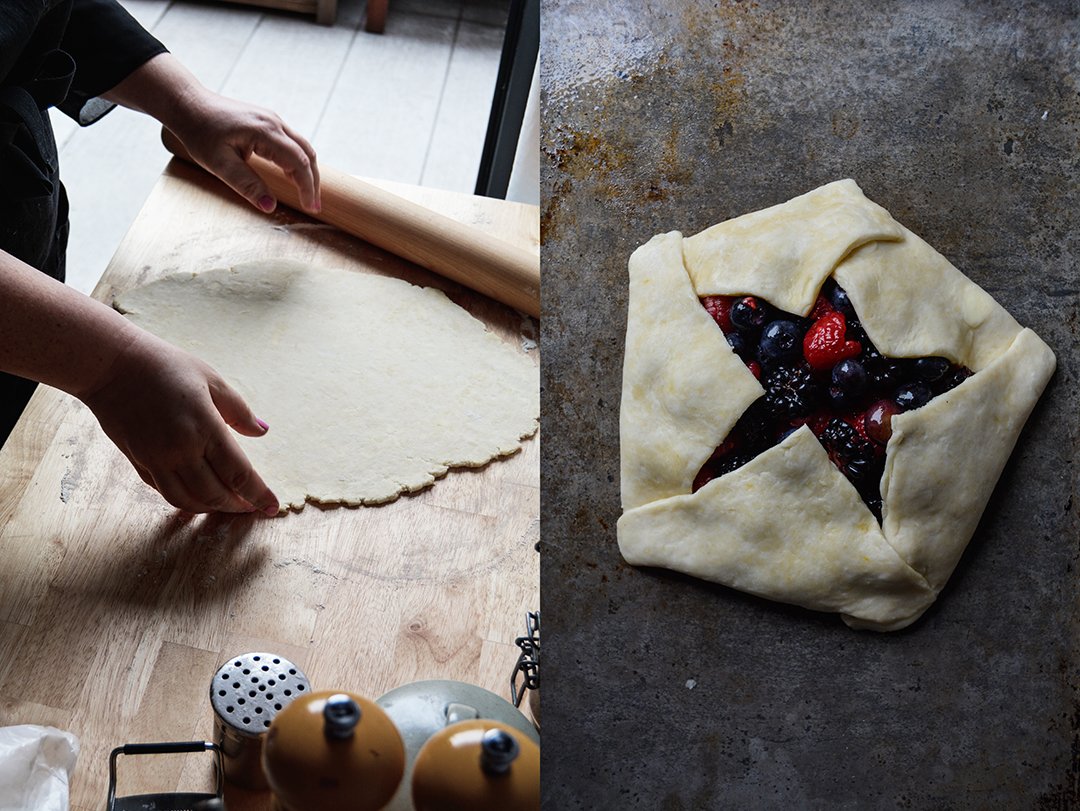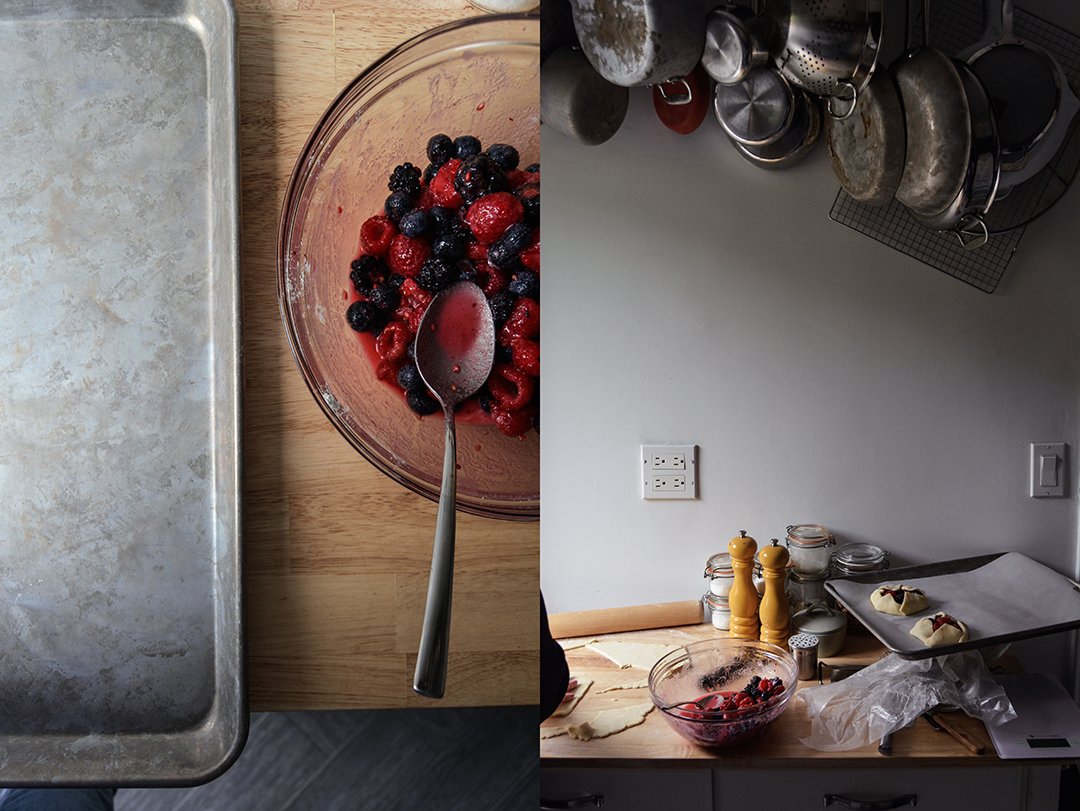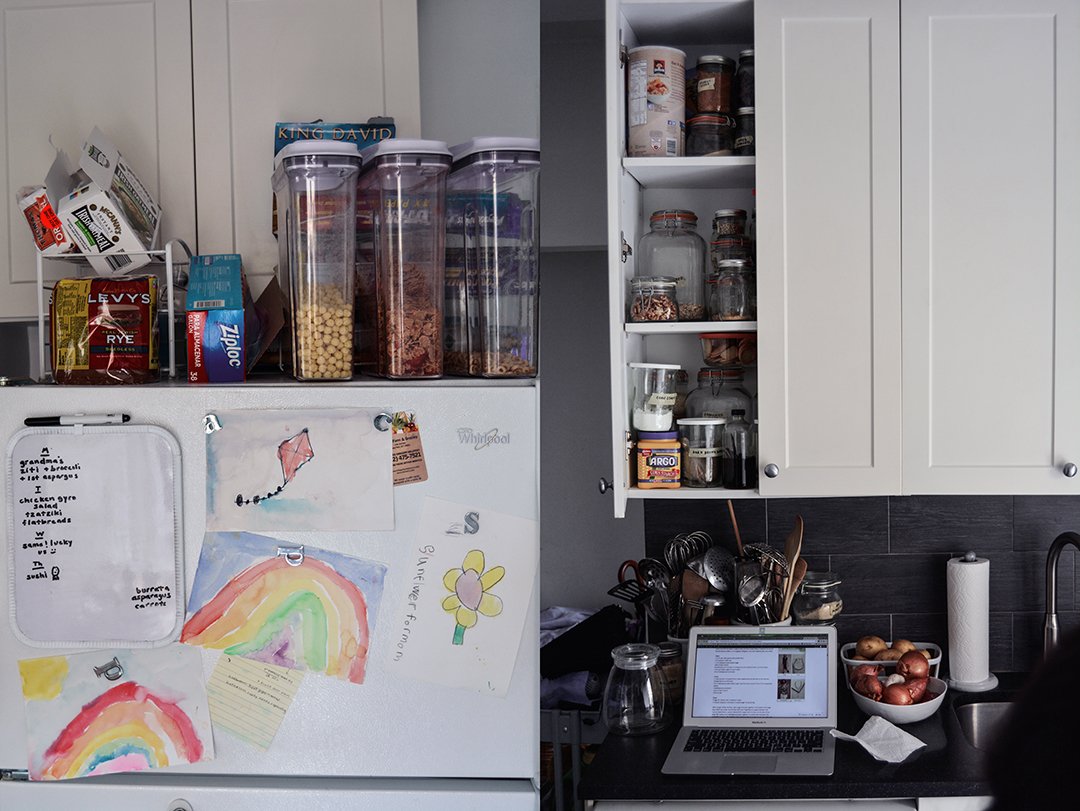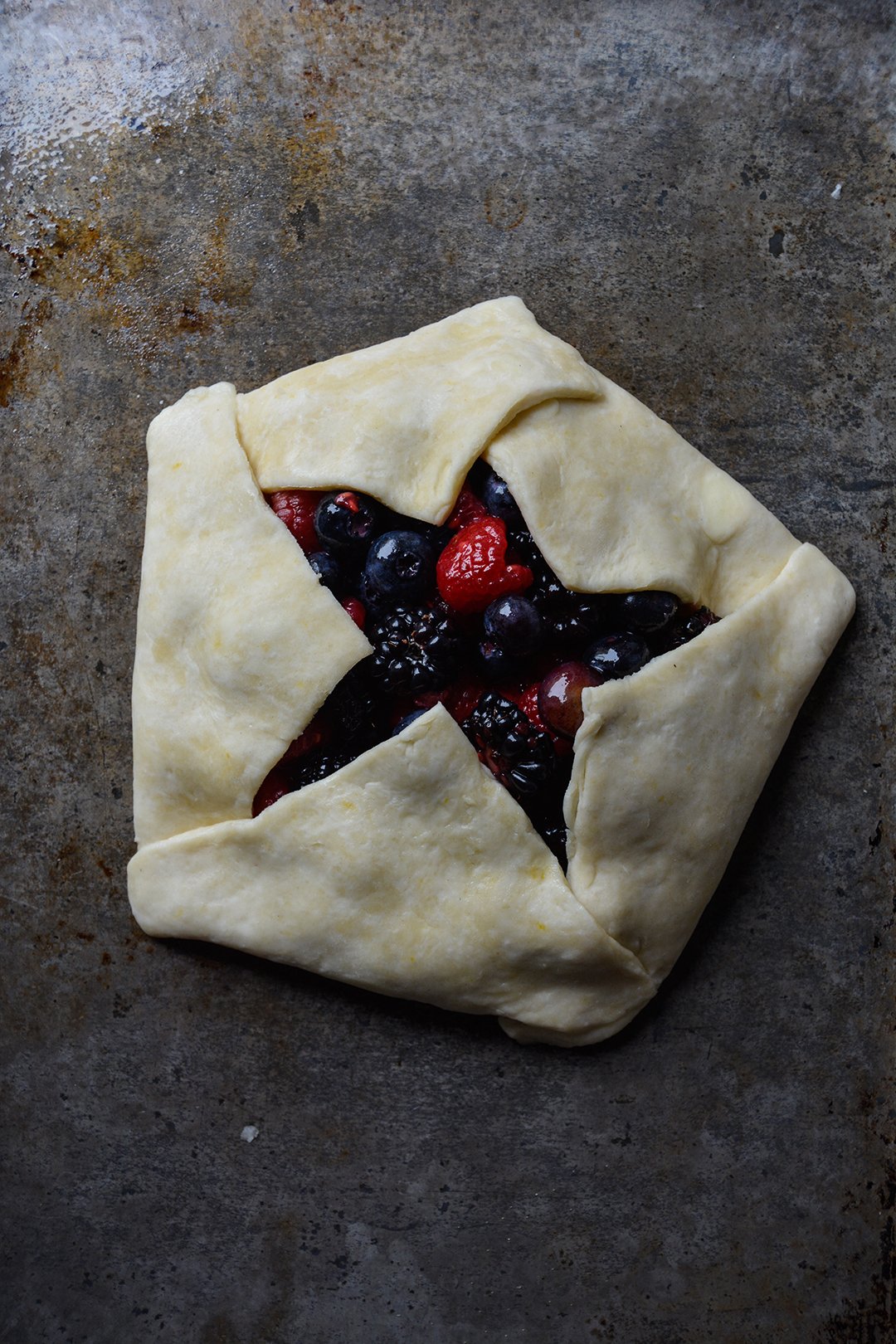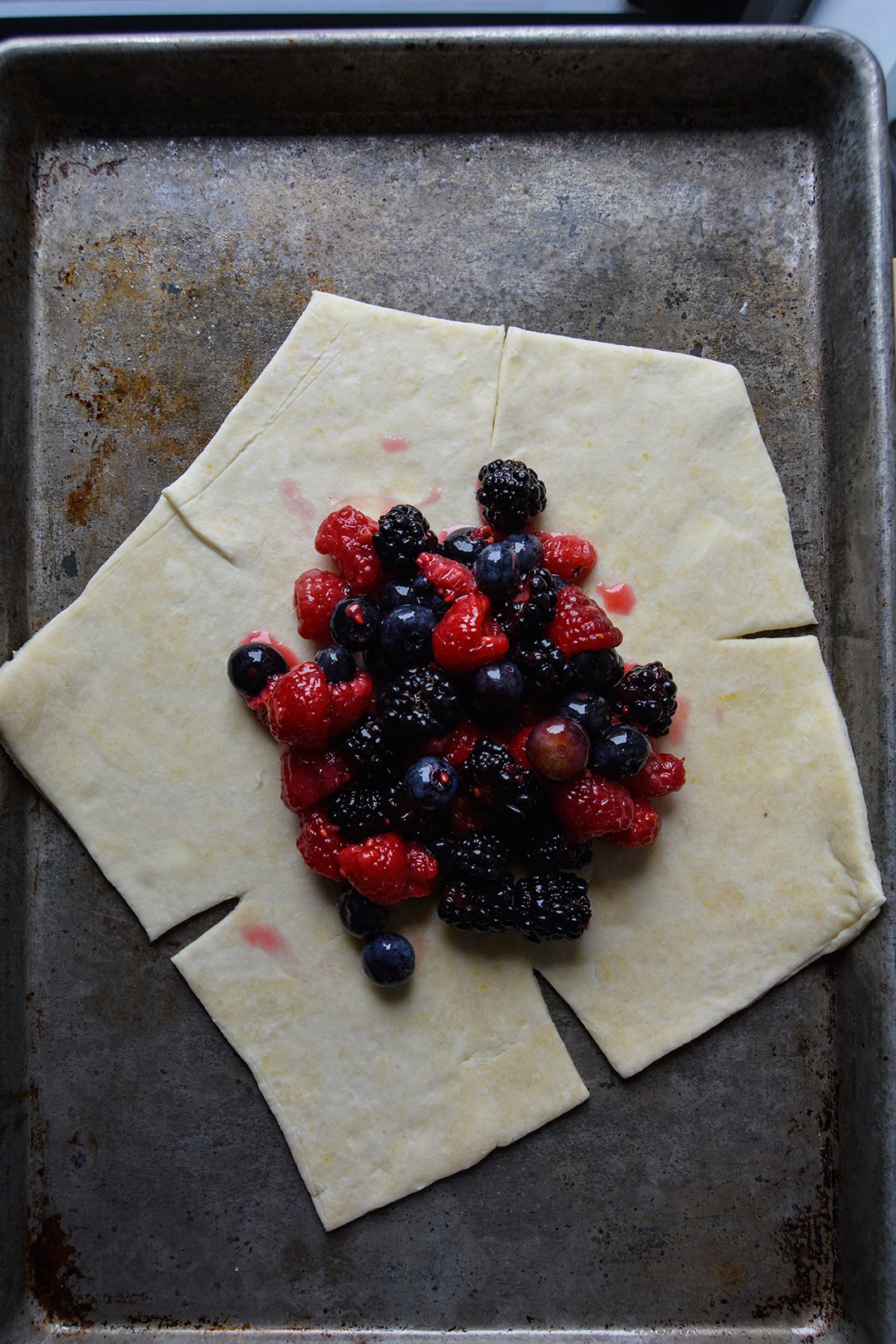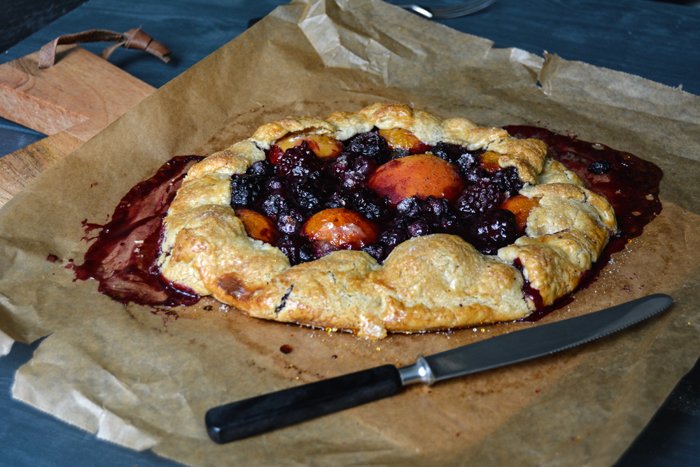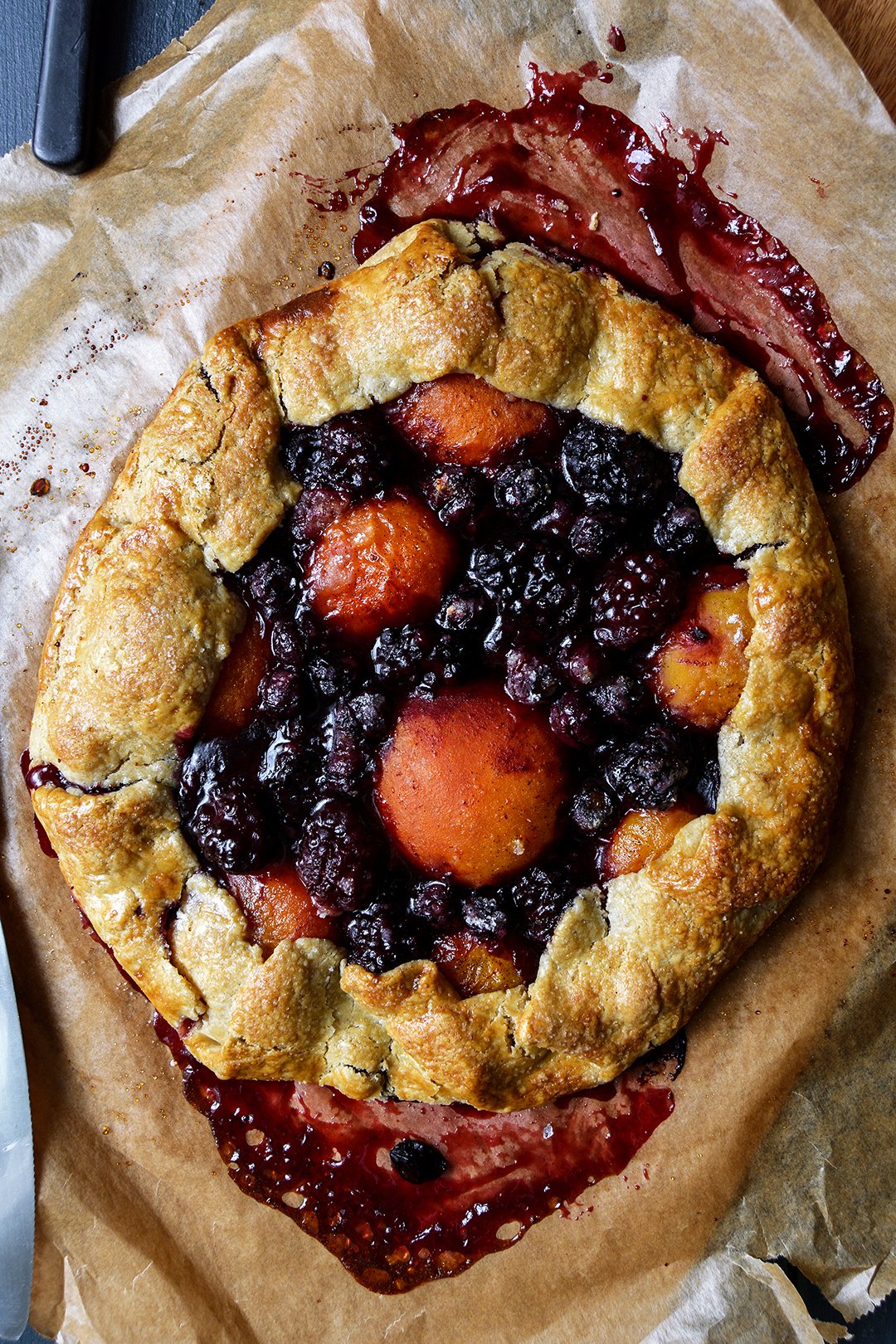Apricot and Basil Galette
Summer baking is the best baking, you can reduce additional sugar to a minimum and focus on some of nature's greatest gifts: stone fruit and berries. They are so packed with sweetness and flavor that adding too much sugar would feel like insulting their creator. However, sneaking in buttery pastry - no matter if it's a crunchy crumble, fragile short crust tart, or rustic galette - fortifies the produce's qualities and has only one effect: you'll want to extend teatime into dinner and just keep nibbling until the sun sets and the last crumb vanishes.
I went for a galette for this recipe because of its summery, picnic-style look but I sneaked a herb into the topping that gives it a slightly unusual touch. Apricot and basil is a fantastic combo for salads and there's no reason why they shouldn't mingle in a fruity tart topping. It's fresh, it's earthy, sweet, and sour, it tastes like a hot day in Tuscany.
Taking some time off for such a rewarding endeavor is the best therapy for a weary mind and soul. And I needed that. I lost my rhythm in the kitchen a little over the last year and half. I created new recipes every day, felt excited about the results and was pleased about being productive. All for my 2nd book, for 365. However, my natural flow of shopping, of planning our dinners, of meeting my man in the kitchen after work and pouring us a glass of wine before starting to cook, this wonderful ease has been disrupted. So much so that it's difficult sometimes to find my way back to my routine, a routine that became the compass of my days over the years. Always pointing towards my next meal, always pointing towards the kitchen. That is my comfort, my safety, and I'm trying to regain orientation.
What I love so much about cooking, about preparing my own food, is the fact that it's totally in my hands. That I can make myself - and others - so unbelievably happy by only throwing a few ingredients together and indulging in this experience on an emotional, sensory, but also intellectual level. I can't think of anything more satisfying than creating a meal that reflects the seasons, my mood, and the desires of my taste buds. This galette tastes heavenly, there's no doubt, it also let's July's plump produce shine, but it challenged me to be experimental, to rethink combinations of ingredients that seem a bit farfetched in the beginning. To combine fleshy apricots and fragrant basil - which usually shines atop my summery Caprese salad or Pizza Margherita - meant I had to open up for a new idea. And that's a good lesson. Always. Even in the most trivial situations. And by doing this, I'm slowly finding my orientation again. Towards the kitchen.
Apricot and Basil Galette
Makes one 23cm / 9″ galette.
For the pastry
180g / 1 1/3 cups plus 1 tablespoon all purpose flour
1 tablespoon light brown sugar
1/4 teaspoon fine sea salt
125g / 1/2 cup plus 1 tablespoon unsalted butter, cold
2 tablespoons water, cold
1 teaspoon cider vinegar
For the galette
4 large apricots (320g / 11 ounces) , pitted and cut in half,
plus 2 large apricots (160g / 5 1/2 ounces), pitted and cut into small cubes
50g / 1/4 cup light brown sugar, plus 1 teaspoon for the topping
1/2 vanilla bean, split and scraped
2 heaping tablespoons roughly chopped basil leaves
1 large egg, beaten
For the pastry, in the bowl of a stand mixer fitted with the paddle attachment, combine the flour, sugar, and salt. Add the butter and use a knife to cut it into the flour until there are just small pieces left. Quickly rub the butter into the flour with your fingers until combined. Add the water and vinegar and quickly mix with the paddle attachment until combined. Form the dough into a thick disc, wrap it in plastic wrap, and freeze for about 15-20 minutes, or until firm.
For the galette, in a small saucepan, heat the apricot cubes (not the apricot halves), the sugar, and vanilla seeds over high heat and cook, stirring occasionally, for about 5 minutes or until the apricots are soft and golden. Reduce the heat if the fruit starts to turn brown. Stir in the chopped basil, transfer to a medium bowl, and let the compote cool for a few minutes.
On a work surface, place the dough between 2 sheets of plastic wrap and use a rolling pin to roll out into a 30cm / 12″ disc. Remove the top layer of plastic wrap and replace it with a piece of parchment paper. Flip the pastry disc over, transfer to a wooden board, and remove the remaining layer of plastic wrap. Spread the apricot-basil compote on top of the pastry, leaving a 5cm / 2″ rim, and arrange the apricot halves, cut side down, on top of the compote. Fold the edges of the pastry up and over the fruit then gently press to seal the folds. Chill the galette, on the wooden board, in the fridge for about 15 minutes or until the pastry is firm.
Place a baking sheet in the middle of the oven and preheat the oven to 200°C / 400°F (conventional setting).
Brush the pastry with the egg wash and sprinkle with 1 teaspoon of sugar. Pull the parchment paper with the galette onto the hot baking sheet and bake for about 35 minutes or until golden brown. Let the galette cool for about 10 minutes before cutting. Serve warm or cold.
Meet In Your Kitchen | Deb Perelman - Smitten Kitchen's Berry Ricotta Galette
Last week I went to New York and I had three wishes on my mind:
1. I wanted to win the James Beard Award (I had strong doubts that that would happen).
2. I wanted to eat oysters at The John Dory.
3. I was hoping that Deb Perelman would open the doors to her famous Smitten Kitchen for a Meet In Your Kitchen feature.
And what can I say, I was a lucky girl. I won the award, I had a fantastic pre-award oyster treat just for myself (if you like oysters, book a table at April's restaurant next time you visit NYC!) - and I met and baked together with Deb!
Smitten Kitchen was the only blog I knew about when I started Eat In My Kitchen in November 2013. I discovered many more in the past three years, but not many managed to keep my attention with such persistence as Deb's. She knows how to entertain, impress, and inspire me with calm ease. Her love for food jumps out of all of her recipes, out of every picture she takes and every line she writes. She's a perfectionist, but she knows how to hide it. She's a charmer.
Deb's blog is a staple in the blog world. She started in 2003 writing about her life in general and focussing on recipes since 2006. When you ask yourself how a single person can build up such a successful food platform on her own and keep it running like a smooth motor, you just have to meet her and you'll know why. Deb is full of life and energy, at the same time down to earth and humble. She's not interested in the blunt surface, in superficial attention, she wants to explore a recipe in depth and present it in all its glory. And here lies her secret: all her recipes make sense, from a cook (or baker) and an eater's point of you. She calls herself a fussy eater, picky like her children, she doesn't mind baking the same cake 14 times until it's just right. This leads to a habit of excessive note taking whenever she's at the cooker. To learn, to improve, and to develop the right formula that she and her readers can totally trust. This trust is what a food blog is built on. Mrs. Perelman takes this task quite easily as she loves what she does, she only cooks the food that she craves herself and that she's curious about. She's like a passionate scientist, working late at night, while everyone else is already in bed, and she's still there, solving culinary problems.
Her journey into and in the kitchen was influenced by her work at a bakery as a teenage girl, by her family with roots in Germany and Russia, Jewish baking, and American cooking. Her mother's cookbook by Julia Child added some French extravagance to the palate and sparked her interest. When you read Deb's blog, you can see that she has a weak spot for comfort food. She might be a fussy eater but she's not into fussy cooking.
After hundreds of recipes developed by herself and shared online, it was time, in 2012, to turn this treasure into a physical publication. When Deb's first cookbook - The Smitten Kitchen Cookbook: Recipes and Wisdom from an Obsessive Home Cook - entered the book shops, it happened anything but quietly. It was a success that screamed for a follow up book. A second child (the cutest baby girl!) and obsessive recipe tasting caused a few delays in the schedule, however, Deb's confident that it's going to happen this year. Her new book will come out soon, including more global influences than in the predecessor's recipes. It's a collection that represents how we cook and eat today. Different cultures from all over the world inspired Deb to experiment with ingredients that are relatively new to our kitchens. The frame, however, is Deb, her style, and her love for American comfort cooking.
We baked the most wonderful berry ricotta galette together, it tasted divine, and the fact that Deb baked it for me made it taste even better.
Berry Ricotta Galette
Recipe by Deb Perelman / Smitten Kitchen
Deb also made a couple small galettes (as you can see in the picture above), but if you aim for the star-shape it's easier to make one large galette. The smaller ones opened in the oven.
Leakage is almost inevitable when making galettes but you shouldn’t sweat it because I’m convinced that it’s more distressing for the baker (who knows exactly how much jammy deliciousness has been lost) than anyone eating a wedge (it will taste like nothing is missing at all).
Here’s the PDF template I made to help you form a star shape, if desired. As should be abundantly evident, I’m no graphic designer, but it will hopefully give you a start.
Makes one 7.5 to 8-inch (19-20cm) galette
For the pastry
1 1/4 cups (160 grams) all-purpose flour
1/2 teaspoon table salt
1 1/2 teaspoons granulated sugar
Zest of half a lemon
8 tablespoons (4 ounces or 113 grams) cold unsalted butter, cut into pieces
1/4 cup (60g) ricotta, yogurt or sour cream
3 to 4 tablespoons cold water
For the filling
2 cups raspberries, blackberries, and blueberries
3 to 4 tablespoons granulated sugar (use the lower amount if your fruit is especially sweet)
2 tablespoons cornstarch
Juice of half a lemon
Pinch of salt
For the glaze
1 egg yolk beaten with 1 teaspoon water
1 heaped teaspoon turbinado or coarse sugar for sprinkling
For the dough, whisk the flour, salt, sugar and zest together in the bottom of a large bowl. Work the butter into the flour with your fingertips or a pastry blender until mixture resembles a coarse meal and the largest bits of butter are the size of tiny peas. Stir ricotta and 3 tablespoons water together in a small dish and pour into butter-flour mixture. Stir together with a flexible spatula as best as you can, then use your hands to knead the mixture into a rough, craggy ball. Wrap in plastic and flatten into a disc. Chill in the fridge for 1 hour or up to 48 hours, or you can quick-firm this in the freezer for 15 minutes.
Preheat the oven to 400°F (200°C).
On a floured counter, roll the dough out into a large round-ish shape, about 14 to 15 inches (36-38cm) across. If you’d like to form your galette into a star, as shown, use the red dashed outline of the PDF template mentioned above. It will print smaller on an 8.5×11-inch (DIN A4) piece of paper than you need, but you can use it as a rough guide to cut as large of a pentagon shape as your dough will allow.
Transfer round or pentagon-shaped dough to a parchment-lined baking sheet; I like to fold my dough gently, without creasing, in quarters then unfold it onto the baking pan. If you’re making a star, cut a 1-inch (2.5cm) notch in the center of each side, angling it toward the center, as shown in the blue dashed lines of the template.
Stir together all of the filling ingredients and spread them in the center of the dough, leaving a 2-inch (5cm) border. If you’re making a round galette, fold the border over the filling, pleating the edge to make it fit. If you’re making a star shape, fold each of the 5 corners into the center, along the green dotted lines of the template. Pinch the outer corners closed, to seal in the filling and the shape (see 6th and 10th picture).
Whisk egg yolk and water together and brush over exposed crust. Sprinkle with coarse sugar.
Bake for 30 minutes, or golden all over. Remove from the oven and let stand for 5 minutes, then slide the galette onto a serving plate. Cut into wedges and serve hot, warm or at room temperature, preferably with vanilla ice cream.
The ever-growing number of Smitten Kitchen's followers has now trusted you for over a decade. What's your secret?
I have no idea how I got so lucky with this. When I got started food blogging in 2006, there was no such thing as turning it into a career so it wasn't even in the remotest corner of my mind. All I wanted to do was create a collection of recipes I considered perfect so once I got a dish the way I liked it, I didn't have to reinvent the wheel every time I was hungry for it. I still feel exactly this way. Having an audience makes it way more fun, but I often wonder if I'd still be doing this in a vacuum because I will always want to cook new things and get them right.
You call yourself a perfectionist, do you feel the drive to perfection just in the kitchen or also in other fields of life? Does the perfect recipe really exist, when do you know you have to stop?
I think near-perfect recipes exist. I don't think every recipe is going to work with every set of ingredients, in every kitchen, at every altitude, at all times but I think when the recipe is very strong, it withstands these variations well. If I think a small thing will throw a recipe immeasurably off though, I won't publish it because I've found in 10+ years of comments that if something can go wrong with a recipe, it sooner than later will for someone.As you've seen my fridge and freezer (since cleaned, but only under duress), I think you know my perfectionism does not extend everywhere in my life. But I do want things the way I want them and I hear from my parents I have been this way from the beginning (sorry guys).
Which of your recipes do you love the most? Which one does your husband and two kids love the most?
We all love the Leite's Consummate Chocolate Chip Cookie, especially now that I've updated them in a way that I can make them more often (I like to stash them in the freezer, bake whenever we remember). And not to be too much of a tease but because this is something I've been working endlessly on for the last couple years, there's a grandma-style chicken noodle soup and a crumb cake in my next cookbook that everyone is nuts for. They never go to waste.
Where do you find inspiration for new recipes?
Oddly, never inside the kitchen. The kitchen is where I test out ideas and pay close attention to what happens, but it's not where new ideas come to me. They come to me when I'm on a train or in a car going somewhere far enough that my mind wanders off, or at a restaurant when I like the flavor intersection of ingredients and want to apply it to something else at home.
How do your family's roots in Germany and Russia influence your cooking and your personal culinary journey?
From my husband's Russian family (he was born there but doesn't remember it), an appreciate of garlic, pickles, sour cream, dill, wafer-y cakes, syrniki (cottage cheese pancakes), as well as the value of a freezer full of pelmeni, vareniki (filled dumplings), and at least one bottle of vodka. From my mom's German side, spaetzle, schnitzel, bretzel, Bienenstich (popular German cake), and every type of almond paste/marzipan confection you can dream up.
What do you enjoy about writing a cookbook and what do you hate about this project? Do you prefer working on your blog or on a book?
I love both for different reasons; the blog is my favorite place to be, to try out ideas, chat with people in the comments, field questions and more. The speed of output and feedback is faster, it lends itself well to cooking whims and streaks; it makes me very happy. Books are less balanced. You spend years (5 years, even!) working through recipes and ideas behind the scenes with an additional layer of design -- I don't know how your book experience was, but I seem to always go 20 rounds with the cover, 45 rounds with the title, 10 rounds with page layouts, and am making recipe swaps until the day I'm cut off, like being at a bar at 2am -- all to yield one (hopefully) wonderful thing that you hope people will want to take home and read and cook from but you have no idea and so, perhaps, the stress is also much greater. But so are the rewards (or is it relief?) should people be as excited about it as you were. I loved getting to book tour last time, and hope to do more this fall.
You have a large cookbook selection in your apartment, what makes a good cookbook in your eyes?
So many things. While I love, like anyone with eyes, looking at beautiful pictures, it's never made a just-okay cookbook a great one. What I love even more is feeling like I'm stepping into a story, a world, with recipes. I love a funny anecdote about how a recipe came to be or a small tidbit I wouldn't have known about a dish. I want the recipes to be airtight, even though I know how hard this is, but to me this is the baseline of a cookbook. And I'm always hoping to see something I hadn't seen before; to feel the creativity bursting from the page.
Do you enjoy being cooked for? On a special night, do you prefer to eat at home or dive into New York's vibrant food scene?
I love being cooked for! I love going out; we used to do it so freely before kids and I do miss it, it's just more complicated with noisy people with early bedtimes. I get so inspired going somewhere teeming with fresh ideas, and it makes me want to come home and cook immediately, so eating out fuels eating in.
Who is your biggest inspiration in the kitchen?
I've always enjoyed Julia Child's tenacity, Marion Cunningham's defense of home cooking against drudgery, and Gabrielle Hamilton's unapologetic embrace of her food vision.
When it comes to school events or a friend's party, do you get requests to bring a dish or are people shy to ask Deb from Smitten Kitchen to bring a birthday cake or sandwiches?
Absolutely not.
What was the first dish you cooked on your own, what is your first cooking memory?
Brownies, I think. Not very different from My Favorite Brownies on my site, but I'd forgotten to add the flour. They were a little burnt at the edges and very mushy in the middle and yes, we still ate them. They weren't even bad, but I never heard the end of it.
What are your favourite places to buy and enjoy food in New York?
Union Square Greenmarket for vegetables and fruit and everything; Murray's or Saxelby for cheese, Kalustyan's for spices and around-the-world ingredients, Buon Italia in Chelsea Market, mostly to load up on the Setaro pasta, Faicco's for spiral sausages for grilling weather, which are always a huge hit, can I go on and on? I could go on and on.
If you could choose one person to cook a meal for you, who and what would it be?
I think my kids should wake up early to make me pancakes this weekend for a change. (I am joking, of course. They are 1 and 7 and our apartment would be in ashes.)
You're going to have ten friends over for a spontaneous dinner, what will be on the table?
Spaghetti with clams or mussels and fries or assemble-your-own steak salads with a side of roasted potatoes.
Do you prefer to cook on your own or together with others?
Solo if I'm working on a new recipe or one I haven't ironed out yet, because I want to be able to pay attention and take notes and make tweaks. If I'm throwing together the above meal for 10 friends, they better be hanging out in the kitchen and drinking wine with me.
Which meals do you prefer, improvised or planned?
Improvised; I like the challenge.
Which meal would you never cook again?
Anything where I've ended up cooking things individually over a stove for many people; I have bad memories of making Fake Shack Burgers for 10 people (so much hamburger grease from head to toe when I was done) as well as an early brunch party where I made French toast for everyone as they trickled in.
Thank you Deb!
Rhubarb Corn Galette with Saffron & we won the James Beard Award!
Last Tuesday we won the James Beard Award. I flew to New York thinking that I had no chance of winning - Ina Garten was nominated in the same category as me: General Cooking. I was sure that this was not going to happen.
And now I’m sitting here at JFK airport, writing these words while waiting for my flight back to Berlin. Trying to think clearly, but I can’t. I wish there were words to describe how I feel, or at least give you a vague idea of what this means to me - but I can’t. It’s almost impossible to talk about a feeling that still shakes me up every time the memories come back and makes my heart fall as if I’m jumping of a cliff. It’s not just in my mind. I feel physically overwhelmed. Just like I did when I went on stage to fall around our host Andrew Zimmern’s neck, to kiss and squeeze him, and to receive the James Beard Foundation medal from his hands (watch my speech here).
When I say we won and not I won, you need to understand that this book, Eat In My Kitchen, would not exist without a bunch of people who gave me all the help, love, support, and inspiration I needed whenever I thought I wouldn’t manage. These people believed in me before I believed in myself, they were the ones who convinced me to trust and follow my instincts:
My editor Holly La Due who guided me through the past two years since we first spoke about a cookbook - and she held my hand in these endless painful seconds before my name was announced at the awards ceremony by legendary Andrew Zimmern; my mother who passed her love for food and wine on to me, the seed out of which Eat In My Kitchen grows every day; everybody at Prestel Publishing and our external experts Lauren Salkeld, Jan Derevjanik, and Ron Longe, who gave everything to make this book look as it looks and stand where it stands. And my family and friends all over the world, your belief in me makes me grow every day. Thank you for trusting me, and for waiting for me patiently.
When your work is recognized and awarded by one of the most critical juries in the food world, a jury who’s not interested in numbers or celebrity status, but in the quality of recipes, it can easily feel intimidating. But that rainy night at New York's Chelsea Piers was not intimidating at all, it was magical. I was in a room together with so many talented people who all love what I love so much - food - and I experienced the warmest welcome to this family (a word that winner Dori Greenspan used). There's a lot of respect, a humble appreciation of the work of the others. Ronni Lundy, Dori Greenspan, Andrew Zimern, Pierre Koffmann, Naomi Duguid, Judith Jones, Keith Pandolfi, Francis Lam and many more (here's the full list of winners), we were awarded for our work, and everybody who came to this event came to celebrate us, but also a passion that we share and that connects us, no matter what part of the world we come from. I want to thank the James Beard Foundation and all the inspiring people who I met that night, a night that I'll never forget in my whole life.
Knowing that I wouldn’t be able to cook or bake anything to share with you when I came back, I made a galette (twice actually because it’s so good) just a few days before I left. It’s a spring treat and it's quite a spectacular one. A crunchy short crust base made of corn flour and spelt flour (you can also use wheat), topped with sour rhubarb and the most fragrant saffron sugar. Cookbook author Yossy Arefi introduced me to this golden spice sugar and inspired me to use it for various sweet pies. Last summer I wrote about her berry galette and I will never forget how the addition of saffron to fruit and buttery crust hit me. It's a true celebration cake.
And now I want to thank you for always pushing me to try out new things in my kitchen, to keep cooking, baking, and writing about what we all love so much: Food!
Photos of the James Beard Award Ceremony by Kent Miller Studios, c/o the James Beard Foundation.
Rhubarb Corn Galette with Saffron Sugar
Update: This recipe is also in my 2nd book, 365: A Year of Everyday Cooking & Baking, Prestel Publishing, 2019
Mind that it's best to prepare the dough for the galette the day before you bake it to give it enough time to chill in the fridge.
Makes one 23cm / 9" galette.
For the pastry
very fine corn flour / corn meal (not corn starch) 90g / 1/2 cup
plain flour (or white spelt flour) 90g / 2/3 cup
granulated sugar 1 tablespoon
fine sea salt 1/4 teaspoon
unsalted butter, cold, 125g / 1/2 cup plus 1 tablespoon
water, cold, 2 tablespoons
cider vinegar 1 teaspoon
For the galette
granulated sugar 75g / 1/3 cup and 1 tablespoon, plus 1 teaspoon for the topping
vanilla bean, scraped, 1/2
saffron threads about 1/8 - 1/4 teaspoon
plain flour (or white spelt flour) 1 tablespoon
fine sea salt 1/8 teaspoon
trimmed rhubarb 280g / 10 ounces
freshly squeezed lemon juice 1 tablespoon
organic egg, beaten, 1
For the pastry, in the large bowl of a stand mixer fitted with the hook attachment, combine the corn flour, flour, sugar, and salt. Add the butter and use a knife to cut it into the flour until there are just small pieces left. Quickly rub the butter into the flour with your fingers until combined. Add the water and vinegar and, using the hooks of the stand mixer, mix until combined. Form the dough into a thick disc, wrap it in plastic wrap, and chill in the fridge overnight (or for a few hours) until hard, or freeze for about 20-30 minutes.
On a table or countertop, place the dough between 2 sheets of plastic wrap and use a rolling pin to roll it out into a 30cm / 12" circle. Pull off the top layer of plastic wrap and replace with a piece of parchment paper. Flip the pastry circle over, transfer to a wooden board, and pull off the remaining layer of plastic wrap. Store the pastry (on top of the wooden board) in the fridge while preparing the topping.
Using a mortar and pestle, grind the sugar, vanilla seeds, and saffron until the saffron is fine and the mixture is well combined. Stir in the flour and salt and set aside.
Cut the rhubarb into 10cm / 4" long pieces and quarter each piece lengthwise. In a large baking dish, using your hands, toss the rhubarb, saffron-sugar, and lemon juice.
Take the pastry out of the fridge and arrange the rhubarb, overlapping, in a circle on top of the dough, leave a 5cm / 2" rim all the way around the fruit (see 10th picture). Sprinkle with any remaining saffron-sugar. Fold the edges of the pastry over the ends of the rhubarb, press to seal the folds. Chill the galette in the fridge for about 10-15 minutes or until the pastry is firm.
Preheat the oven to 200°C / 400°F (conventional setting). Place a baking sheet in the middle of the oven while preheating.
Brush the pastry with the egg wash and sprinkle with 1 teaspoon of sugar. Take the hot baking sheet out of the oven and pull the galette with the parchment paper onto the baking sheet. Bake for about 30 minutes or until golden brown. Let the galette cool for about 10 minutes before cutting. Serve warm or cold.
Nominee - Winner:
Yossy Arefi's fantastic Apricot and Berry Rye Galette with Saffron Sugar
Yossy and I share the same passion for one of the best combinations a coffee table has ever seen: juice-dripping fruit and buttery pastry. When I first saw one of Yossy's famous fruit galettes a couple years ago, I immediately fell in love with its honest and rustic look. And as the New York food writer and photographer announced the birth of her first cookbook, Sweeter Off The Vine, a couple months ago, I was hoping that she'd include a recipe for one of her gorgeous open pies. Yossy didn't let me down and she had my full attention when I spotted her Apricot and Berry Galette with Saffron Sugar made with rye pastry. This innocent pie tastes as good as it looks. Theoretically, I could have eaten the whole cake on my own - and I would have loved to! - but we had guests over for dinner and they enjoyed our fruity dessert just as much as I did, so I had to share.
Yossy Arefi is the creator behind the beautiful blog Apt. 2B Baking Co. and she managed to create a second masterpiece (after her blog) with Sweeter Off The Vine. The book is a gorgeous recipe collection from start to finish, following the seasons with colourful creations that celebrate nature's crop at its peak. Rhubarb and berries, stone fruits and melons, figs, apples, and pears, Yossy didn't leave a single craving of mine unanswered. As I thumbed through the pages, I got lost in her honest and pure, and somehow poetic photography. Nothing feels artificial, the whole book is true and manages to speak to the hungry mind without distraction. Her ice creams, tarts, desserts, and pies look like the food you want to eat in your granny's kitchen, but the young woman from New York always manages to sneak in her little additions that make the recipes very modern at the same time. Aromatic spices, like saffron, vanilla and citrus, orange blossom and rose water, or fresh vanilla bean are used in almost all of her recipes. Yossy's family roots are in Iran, and this heritage brought in her great fascination for the wonderful flavours of Middle Eastern cooking and her love for contrasts.
Apricot and Berry Rye Galette with Saffron Sugar
Recipe from Sweeter off the Vine: Fruit Desserts for Every Season by Yossy Arefi, Ten Speed Press.
Makes 1 9" (23cm) galette
For the rye pie crust
2/3 cup (85g) rye flour
2/3 cup (85g) all purpose flour
1/2 teaspoon salt
1/2 cup plus 1 tablespoon (125g) very cold unsalted butter
1/2 tablespoon apple cider vinegar
4 tablespoons (60ml) ice water
For the galette
1/2 vanilla bean
3 tablespoons granulated sugar
pinch saffron threads
2 teaspoons all purpose flour
pinch salt
8 ounces (225g) apricots
1/2 cup (80g) blueberries
1/2 cup (80g) blackberries
1/4 cup (60g) apricot jam (I used blueberry jam)
1 large egg, lightly beaten for egg wash
1 tablespoon turbinado sugar
Whisk the flour and salt together in a large bowl, cut the butter into 1/2-inch (1 1/4cm) cubes, and add the apple cider vinegar to the ice water.
Working quickly, add the butter to the flour and toss to coat. Then use your fingers or the palms of your hands to press each cube of butter into a flat sheet. Keep tossing the butter in the flour as you go to ensure that each butter piece is coated with flour. The idea is to create flat, thin shards of butter that range from about the size of a dime to about the size of a quarter.
If at any time the butter seems warm or soft, briefly refrigerate the bowl.
Sprinkle about 3 tablespoons of the icy cold vinegar-water mixture over the flour mixture. Use a gentle hand or wooden spoon to stir the water into the flour until just combined. If the dough seems dry, add more cold water a couple of teaspoons at a time. You have added enough water when you can pick up a handful of the dough and easily squeeze it together without it falling apart.
Press the dough together, form into a disk, and wrap in plastic wrap. Chill the dough for at least 2 hours before using, but preferably overnight. Keeps for up to three months in the freezer wrapped in a double layer of plastic wrap and a layer of foil. Thaw in the refrigerator before using.
Line a large baking sheet with parchment paper. On a lightly floured surface, roll the dough into a roughly 12-inch (30cm) circle, just under 1/4-inch (1/2cm) thick; it’s okay if it isn’t perfectly round. Transfer the dough to the prepared baking sheet. Store in the fridge while you prepare the filling.
Use the tip of a knife to cut the vanilla bean in half lengthwise and scrape out the seeds. Reserve the pod for another use. Add the granulated sugar to a mortar, add the vanilla seeds and saffron threads, and grind with a pestle until finely ground. The sugar will turn pale yellow and smell wonderful. Stir in the flour and salt.
Gently tear the apricots in half. Place the apricot halves into a large bowl and discard the pits. Add the berries and the saffron-vanilla sugar mixture to the bowl and toss with your hands to combine.
Remove the dough from the fridge and spread the jam on top, leaving a 2-inch (5cm) border around the edges, then top with the fruit. Fold the edges of the pastry over the fruit and press gently to seal the folds. Chill the formed tart until the dough is firm, about 15 minutes.
Position a rack in the center of the oven and preheat to 400ºF (200ºC). When the tart is nice and cold remove it from the fridge and gently brush the dough with the egg wash; sprinkle with the turbinado sugar.
Bake until the fruit juices bubble and the pastry is deep golden brown, 30 to 40 minutes. Let cool slightly before serving. This tart is best served the day it’s made.









